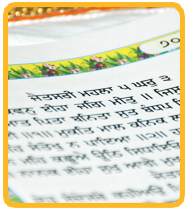We can perceive the uniqueness in interpretation of Ghar as well as uniqueness in pronunciation of Ghar from within Sri Guru Granth Sahib . In fact, there are two directives in Sri Guru Granth Sahib regarding unique pronunciation and interpretation of Ghar .
At SGGS 23, there is first directive in the heading of a sabad, which reads ਸਿਰੀ ਰਾਗੁ ਮਹਲਾ ੧ ਘਰੁ ਦੂਜਾ ੨ ॥
Herein, after mention of Raag and Mahalla, the Ghar of the sabad is spelt (ਦੂਜਾ) as Dooja to explain its pronunciation. Had it been related solely to the pronunciation, there would have only been mention of Dooja. However, the spelling of Dooja is also followed by the digit ‘੨’. This clearly signifies that not only the pronunciation of Ghar has to be as Dooja but also indicates that Dooja has to be interpreted as two ghars as well.
The entire sabad is as under;
ਸਿਰੀ ਰਾਗੁ ਮਹਲਾ ੧ ਘਰੁ ਦੂਜਾ ੨ ॥
ਆਪੇ ਰਸੀਆ ਆਪਿ ਰਸੁ ਆਪੇ ਰਾਵਣਹਾਰੁ॥
ਆਪੇ ਹੋਵੈ ਚੋਲੜਾ ਆਪੇ ਸੇਜ ਭਤਾਰੁ॥੧॥
ਰੰਗਿ ਰਤਾ ਮੇਰਾ ਸਾਹਿਬੁ ਰਵਿ ਰਹਿਆ ਭਰਪੂਰਿ॥੧॥ ਰਹਾਉ ॥
ਆਪੇ ਮਾਛੀ ਮਛੁਲੀ ਆਪੇ ਪਾਣੀ ਜਾਲੁ॥
ਆਪੇ ਜਾਲ ਮਣਕੜਾ ਆਪੇ ਅੰਦਰਿ ਲਾਲੁ॥ ੨ ॥
ਆਪੇ ਬਹੁ ਬਿਧਿ ਰੰਗੁਲਾ ਸਖੀਏ ਮੇਰਾ ਲਾਲੁ॥
ਨਿਤ ਰਵੈ ਸੋਹਾਗਣੀ ਦੇਖੁ ਹਮਾਰਾ ਹਾਲੁ॥੩॥
ਪ੍ਰਣਵੈ ਨਾਨਕੁ ਬੇਨਤੀ ਤੂ ਸਰਵਰੁ ਤੂ ਹੰਸੁ॥
ਕਉਲੁ ਤੂ ਹੈ ਕਵੀਆ ਤੂ ਹੈ ਆਪੇ ਵੇਖਿ ਵਿਗਸੁ॥੪॥ (SGGS 23)
Let us verify this supposition in the directive enshrined in Sri Guru Granth Sahib at SGGS 23. The two ghars in each tuk of the above sabad, other than the Rahao pada, are as under;
ਸਿਰੀ ਰਾਗੁ ਮਹਲਾ ੧ ਘਰੁ ਦੂਜਾ ੨ ॥
iਆਪੇ ਰਸੀਆ ਆਪਿ ਰਸੁ iiਆਪੇ ਰਾਵਣਹਾਰੁ॥
iਆਪੇ ਹੋਵੈ ਚੋਲੜਾ iiਆਪੇ ਸੇਜ ਭਤਾਰੁ॥1॥
ਰੰਗਿ ਰਤਾ ਮੇਰਾ ਸਾਹਿਬੁ ਰਵਿ ਰਹਿਆ ਭਰਪੂਰਿ॥੧॥ ਰਹਾੳ॥
iਆਪੇ ਮਾਛੀ ਮਛੁਲੀ iiਆਪੇ ਪਾਣੀ ਜਾਲੁ॥
iਆਪੇ ਜਾਲ ਮਣਕੜਾ iiਆਪੇ ਅੰਦਰਿ ਲਾਲੁ॥ ੨ ॥
iਆਪੇ ਬਹੁ ਬਿਧਿ ਰੰਗੁਲਾ iiਸਖੀਏ ਮੇਰਾ ਲਾਲੁ॥
iਨਿਤ ਰਵੈ ਸੋਹਾਗਣੀ iiਦੇਖੁ ਹਮਾਰਾ ਹਾਲੁ॥੩॥
iਪ੍ਰਣਵੈ ਨਾਨਕੁ ਬੇਨਤੀ iiਤੂ ਸਰਵਰੁ ਤੂ ਹੰਸੁ॥
iਕਉਲੁ ਤੂ ਹੈ ਕਵੀਆ ਤੂ ਹੈ iiਆਪੇ ਵੇਖਿ ਵਿਗਸੁ॥੪॥ (SGGS 23)
This verifies the inference of digit ‘੨’ after mention of Ghar ‘Dooja’ above. Whereas each tuk of the above sabad possesses two ghars, the Rahao pada has to be interpreted separately and shall be discussed elsewhere.
Likewise, the second and last directive for pronunciation and interpretation of Ghar, that is again about Ghar 2, at SGGS 524. Whereas, at SGGS 23 (above) Guru Sahib has first inserted the spelling of pronunciation of Dooja (Second) and then mentioned ‘2’ whereas at SGGS 524, Guru Sahib has mentioned ‘2’ first, and then spelt its pronunciation, thereby asserting that there are two ghars that are mentioned as Ghar Dooja. The heading of Ghar 2 at SGGS 524 reads as ਸ੍ਰੀ ਕਬੀਰ ਜੀਉ ਕਾ ਚਉਪਦਾ ਘਰੁ ੨ ਦੂਜਾ. The sabad is as under;
ਸ੍ਰੀ ਕਬੀਰ ਜੀਉ ਕਾ ਚਉਪਦਾ ਘਰੁ ੨ ਦੂਜਾ ॥
ਚਾਰਿ ਪਾਵ ਦੁਇ ਸਿੰਗ ਗੁੰਗ ਮੁਖ ਤਬ ਕੈਸੇ ਗੁਨ ਗਈਹੈ ॥
ਊਠਤ ਬੈਠਤ ਠੇਗਾ ਪਰਿਹੈ ਤਬ ਕਤ ਮੂਡ ਲੁਕਈਹੈ ॥੧॥
ਹਰਿ ਬਿਨੁ ਬੈਲ ਬਿਰਾਨੇ ਹੁਈਹੈ ॥
ਫਾਟੇ ਨਾਕਨ ਟੂਟੇ ਕਾਧਨ ਕੋਦਉ ਕੋ ਭੁਸੁ ਖਈਹੈ ॥੧॥ ਰਹਾਉ ॥
ਸਾਰੋ ਦਿਨੁ ਡੋਲਤ ਬਨ ਮਹੀਆ ਅਜਹੁ ਨ ਪੇਟ ਅਘਈਹੈ ॥
ਜਨ ਭਗਤਨ ਕੋ ਕਹੋ ਨ ਮਾਨੋ ਕੀਓ ਅਪਨੋ ਪਈਹੈ ॥੨॥
ਦੁਖ ਸੁਖ ਕਰਤ ਮਹਾ ਭ੍ਰਮਿ ਬੂਡੋ ਅਨਿਕ ਜੋਨਿ ਭਰਮਈਹੈ ॥
ਰਤਨ ਜਨਮੁ ਖੋਇਓ ਪ੍ਰਭੁ ਬਿਸਰਿਓ ਇਹੁ ਅਉਸਰੁ ਕਤ ਪਈਹੈ ॥੩॥
ਭ੍ਰਮਤ ਫਿਰਤ ਤੇਲਕ ਕੇ ਕਪਿ ਜਿਉ ਗਤਿ ਬਿਨੁ ਰੈਨਿ ਬਿਹਈਹੈ ॥
ਕਹਤ ਕਬੀਰ ਰਾਮ ਨਾਮ ਬਿਨੁ ਮੂੰਡ ਧੁਨੇ ਪਛੁਤਈਹੈ ॥੪॥੧॥
The number of ghars in each tuk, other than the Rahao pada, of the sabad in Sri Guru Granth Sahib at SGGS 524 are as under;
ਸ੍ਰੀ ਕਬੀਰ ਜੀਉ ਕਾ ਚਉਪਦਾ ਘਰੁ ੨ ਦੂਜਾ ॥
iਚਾਰਿ ਪਾਵ ਦੁਇ ਸਿੰਗ ਗੁੰਗ iiਮੁਖ ਤਬ ਕੈਸੇ ਗੁਨ ਗਈਹੈ ॥
iਊਠਤ ਬੈਠਤ ਠੇਗਾ ਪਰਿਹੈ iiਤਬ ਕਤ ਮੂਡ ਲੁਕਈਹੈ ॥੧॥
ਹਰਿ ਬਿਨੁ ਬੈਲ ਬਿਰਾਨੇ ਹੁਈਹੈ ॥
ਫਾਟੇ ਨਾਕਨ ਟੂਟੇ ਕਾਧਨ ਕੋਦਉ ਕੋ ਭੁਸੁ ਖਈਹੈ ॥੧॥ ਰਹਾਉ ॥
iਸਾਰੋ ਦਿਨੁ ਡੋਲਤ ਬਨ ਮਹੀਆ iiਅਜਹੁ ਨ ਪੇਟ ਅਘਈਹੈ ॥
iਜਨ ਭਗਤਨ ਕੋ ਕਹੋ ਨ ਮਾਨੋ iiਕੀਓ ਅਪਨੋ ਪਈਹੈ ॥੨॥
iਦੁਖ ਸੁਖ ਕਰਤ ਮਹਾ ਭ੍ਰਮਿ ਬੂਡੋ iiਅਨਿਕ ਜੋਨਿ ਭਰਮਈਹੈ ॥
iਰਤਨ ਜਨਮੁ ਖੋਇਓ ਪ੍ਰਭੁ ਬਿਸਰਿਓ iiਇਹੁ ਅਉਸਰੁ ਕਤ ਪਈਹੈ ॥੩॥
iਭ੍ਰਮਤ ਫਿਰਤ ਤੇਲਕ ਕੇ ਕਪਿ ਜਿਉ iiਗਤਿ ਬਿਨੁ ਰੈਨਿ ਬਿਹਈਹੈ ॥
iਕਹਤ ਕਬੀਰ ਰਾਮ ਨਾਮ ਬਿਨੁ iiਮੂੰਡ ਧੁਨੇ ਪਛੁਤਈਹੈ ॥੪॥੧॥ (SGGS 524)
Presence of two ghars in each tuk again verifies the inference of digit ‘੨’ after mention of Ghar ‘Dooja’ above.
The numerical (੨) and the word “Dooja” (i.e. second) is a clear directive that whenever a numerical is attributed to Ghar, its pronunciation is unique and implies its unique interpretation in the concept of Ghar.
On applying these directives for pronunciation and interpretation of other types of Ghar e.g. Ghar 3, Ghar 4 and Ghar 5 etc., the pronunciation of such ghars shall be Ghar Teeja, Ghar Chautha, and Ghar Panjvan and so on and shall imply presence of three ghars, four ghars, five ghars respectively.
When this interpretation was closely observed in all sabads of Sri Guru Granth Sahib, it was actually found that the same principle applies to all other ghars of Sri Guru Granth Sahib. Each Ghar has been discussed separately in various chapters of this book.
Let us now elaborate on the grammatical aspect. We often get carried away with our knowledge of Punjabi language and its grammar. We need to know that grammar of Punjabi language is only intended for Punjabi language. There is Gurbani grammar for interpretation of Gurbani. Gurbani does not follow the rules of grammar of Punjabi language, like the rule of masculine/feminine gender and singular-plural is different for Punjabi language in Punjabi grammar and different for Gurbani in Gurbani grammar. Similarly, the usage and interpretation of bindi diacritical mark, as it is done in Gurbani, is out of the scope of grammar of Punjabi language. When we try to apply grammar of Punjabi language on Gurbani, we end up with construed inferences.
Similarly, when there are other diacritical marks (called ਮਾਤਰਾ in Punjabi) viz. sihari, bihari, dullawan, onker, attached to last letter of various words in Gurbani, their interpretation is beyond the mandate of Punjabi grammar. Therefore, application of knowledge of Punjabi grammar in interpretation of such diacritical marks on last letters of Gurbani is often misleading.
The word Ghar (ਘਰੁ) has a diacritical mark viz. onker (ਔਂਕੜ) on its last letter. However, other than pronunciation, the Punjabi language, and its grammar, has no explanation to the presence of onker with last letter of Ghar i.e. ਘਰੁ, whereas, it is often used in Gurbani despite it is not related to pronunciation.
We need to understand the usage and interpretation of these diacritical marks in Gurbani. Whenever there is a sihari, bihari, dullawan and onker diacritical marks (matras) on the last letter of any word in Gurbani, it often implies presence of other hidden word(s) that is/are associated to the word bearing the diacritical mark on last letter.
The diacritical mark in Ghar (ਘਰੁ) is onker. As per Gurbani grammar, any word with onker diacritical mark is a noun and singular. And as a noun, it is awkward to assume a noun to be quantitatively interpreted as three, four, five etc. In addition to the routine usage of onker (ਓਂਕੜ) diacritical mark for noun and in singular sense, there is another unique usage of onker diacritical mark. This unique usage of onker is to convert a noun, pronoun or verb into a title. Thereby, Ghar with onker diacritical mark (ਘਰੁ) gets transformed into a title. And when a title, Ghar with onker diacritical mark is interpreted as ‘Concept of Ghar’. When digits are attached to this entitled Ghar (ਘਰੁ), like Ghar 1 (ਘਰੁ 1), Ghar 2 (ਘਰੁ 2), Ghar 3 (ਘਰੁ 3) etc.; Ghar 1 (ਘਰੁ 1) is interpreted as ‘Concept of Ghar 1’; Ghar 2 (ਘਰੁ 2) is interpreted as ‘Concept of Ghar 2’, Ghar 3 (ਘਰੁ 3) is interpreted as ‘Concept of Ghar 3’ and so on.
This transformation of a noun i.e. Ghar (ਘਰੁ) into a title is very much like transformation of a verb i.e. Jap (ਜਪ) into a title Jap (ਜਪੁ ) with insertion of an onker (ਓਂਕੜ) diacritical mark in ਜਪ. While Jap without any diacritical mark (ਜਪ) is a verb which means ‘to meditate’, however, the entitled Jap with onker diacritical mark on its last letter (ਜਪੁ), is interpreted as ‘The bani of Jap’ that incorporates all paoris and saloks.
The term Ghar, at times, is also accompanied with sihari matra (ਘਰਿ). This diacritical mark (sihari matra) being on the last letter of Ghar associates a hidden word (in) to transform the interpretation of Ghar with diacritical mark (sihari matra) i.e. ਘਰਿ as ‘in Ghar’. Thus, the word ‘in’ has got associated because sihari diacritical mark is attached to the last letter of the word Ghar (ਘਰਿ). This concept is out of scope of grammar of Punjabi language!








